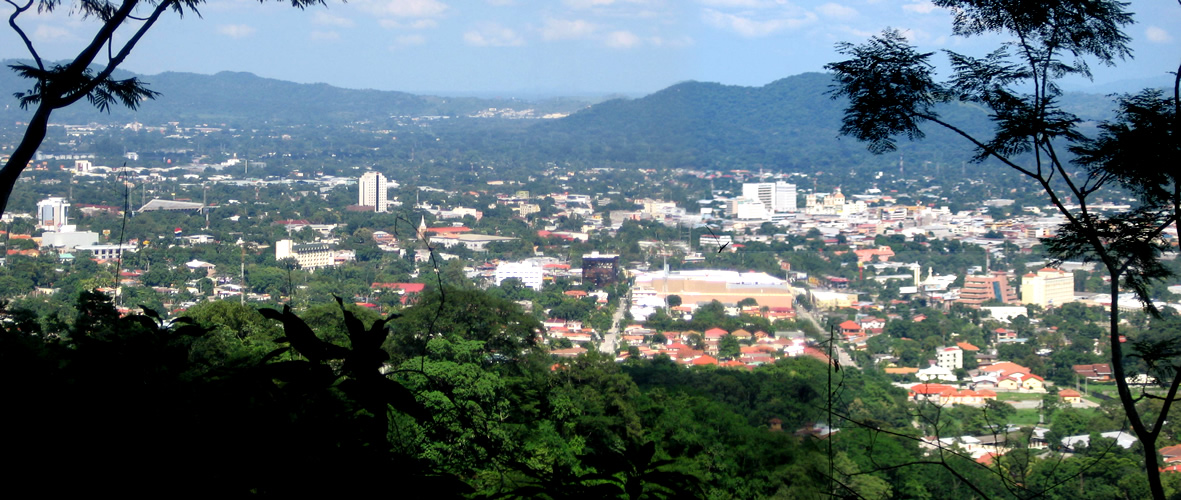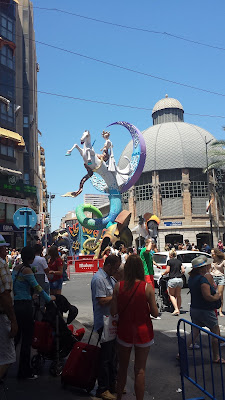Since I came to Spain, I have not come across a topic as divisive as bullfighting. If you bring the topic up in a crowded room, you're going to get embarrassed grimaces and an awkward silence; but as we walked into the Plaza de Toros with a couple thousand Alicantinos, bullfighting seemed as popular and alive as ever.
I honestly shared some of Syed's nervousness on the topic of cruelty. I have seen my fair number of animals get put down, even actively doing so myself; but at the surface this seemed a more drawn out version of that. It did not seem like the same clean and, hopefully, quick death that we hoped for when hunting.
The
Plaza was a lot like what you imagine a Roman arena would look like. It was a round stone auditorium. In the center was a red clayish dirt with two concentric circles in white chalk. The majority of the seating was in the "bowl" area, but there were nosebleeds, as well as box seats.
With the sound of fanfare, the players came into the stage.
In a normal bullfight you have a total of six bulls to be paired two each by three bullfighters. What finally convinced me to come watch is that I recognized the name of the headliner, El Fandi. El Fandi is currently the best bullfighter in Spain, and he guarantees a show wherever he goes (You kinda have to when you are called "El" anything).
The first fight was exactly what I didn't want to watch; slow, torturous and full of mistakes. I was really surprised when the entire crowd recognized this and let the bullfighter know; the disapproving whistles coming down from the crowd drowned out any of the sounds from the arena. Disgraced, the bullfighter had to put down the bull by severing the spinal cord and not by the preferred sword to the heart.
The second fight was better, the crowd was more into the fight and the bravery and bravado of the Torero got the crowd going.

The third bull was taken on by El Fandi. He had been on the sidelines talking with the other two
Matadores, and, it appeared, giving them pointers. He and his c
uadrilla stepped into the arena with chants of "Fandi, Fandi" going around the crowd. All of them were dressed in a similar style, but Fandi's
Traje de Luces shimmered in the sunset light. It was almost like a million camera flashes coming from every point in his jacket.
A fanfare sounded, a door opened, and a charging black mass ran into the arena. The black bull was massive, a large hump behind the neck, and menacing horns that you definitely wanted to stay away from. El Fandi got on his knees with his purple and yellow cape, and, in one move and while still kneeling, brought the cape over the bulls head, over his own, and down to the dirt. The crowd went wild. He then continued in a more orthodox style, making the bull dance for him and waving the cape in amazing geometric patterns. The men on horseback came out, lanced the bull behind the head, and, with a second fanfare, the first period was over.
The second period of a bullfight is called Tercio de Banderillas, in which flags on barbed hooks are driven into the bull's back. This is usually done by Banderilleros, who assist the Torero in this duty, but El Fandi walked out himself, one flag in each hand. He then told his assistants with capes to stand back, and he was suddenly one-on-one with the bull. As the bull charged, he placed both flags perfectly on each side of his spine.
He then went to the sideline and grabbed four, two in each hand. Murmurs could be heard from the crowd, uncertain of what he was going to do. As the bull charged a second time, El Fandi strafed sideways and with a steep arch, drove both flags in his right hand into the bull's large hump. As the bull turned, annoyed, and came at him a third time; El Fandi was ready, one flag in each hand. As he drove the final two flags into the gored back of the bull, the crowd exploded in cheers and applause. A now bare-handed torero was being chased around the ring by an angry thousand-pound bull. El Fandi put a hand forward, around the bull's forhead, and, as he ran backwards, managed to coerce the bull into stopping his charge. A final fanfare announced the start of the third period.
At this point I had understood that this show wasn't about making an animal suffer for amusement, or just a way to provide the town with around 6,000 pounds of beef in one sitting (which it is), but rather a celebration of bravery. Proving to everyone in attendance that you have complete control of a bull to the point to where you can make a killing machine dance with you, and doing it nonchalantly to make it seem easy. Proving you've got the biggest cojones in the entire arena (including the bull's), and that no one would even try to do what you're doing. Looking danger literally in the face and laughing. Maybe if I would have been born in Sevilla I would have wanted to be a torero, and maybe in an alternate universe I am one, because honestly it sounds like something I'd like to do.
El Fandi picked up his red cape and his sword and, as the in-house band started playing traditional Spanish music, prepared for the final dance.
The final round was the mano-a-mano and the fitting and honorable end of the fight. The bull charged time and time again at the Torero's request, and after three or four charges, El Fandi would turn his back on the bull to salute the crowd and celebrate as the entire arena yelled Ole.
As the fight wore on, the crowd began to take out their white handkerchiefs to salute the Matador.
The biggest surprise of the event came as El Fandi was coming towards the end of the fight. The arena began yelling "Indulto! Indulto!", which in Spanish means Pardon. If a bull performs exceptionally well in the ring, the crowd may decide to spare his life; which was what was happening now. The entire arena was pleading to the Presidente (who presides over the arena and serves a the main judge) to pardon the bull, let it get treated by a vet and get released back to his free-range ranch to become a breeding bull. It was a scene straight out of a Roman gladiator arena, and I could even imagine (I couldn't see the President myself) the President sticking his thumb out to decide the bull's fate.
El Fandi was standing over the bull, red cape in his left hand lowered to keep the bull's interest, and in his right hand, his sword, menacingly pointed at the bull. He was looking up for a decision from the Presidential balcony. I saw him register the order with a sigh and a look of disappointment. He turned his attention to the bull. The entire arena grew silent.
With one sleek, coherent movement, El Fandi lowered the cape and began thrusting the sword towards the bull. With one final charge, the bull dipped his head to reach down towards the red cape, exposing his weakened neck. The sword began burrowing into the bull's flesh, driven by both the Matador's strength and the bull's charge, until the entire blade had impaled the bull and only the hilt of the sword stuck out from the bull's back. El Fandi, at this point, had jumped to dodge the final cornada, and was out of harm's way as the bull's heart bled out and the bull began to lose its footing.
The arena was a mixture of somber applause for the bull and Torero, and vulgar insults directed at the President. As the bull hit the dirt, he was quickly granted the coup de grace with a dagger by one of the assistants. Two large workhorses came in, and the bull was granted a lap of honor around the arena as the entire crowd paid their respects. Half-way through the lap the horses stopped, and El Fandi came over to kiss the bull, pat it a couple of times and give it a half hug. It was then hauled off to insides of the arena.
A short time afterwards, a man dressed in what I can only describe as Medieval minstrel chic gave El Fandi two large tufts of fur; the bull's ears. The entire crowd cheered as El Fandi held the trophies up (proof of an excellent fight) and eventually parted with them by throwing them into the crowd (after he threw the first one, I half expected a t-shirt cannon to be brought out and used for launching bull ears into the upper sections of the arena).
There were three more fights after this one, and they were alright, but it was nothing compared to the third fight. As we walked out after the third one, we got the rare chance to see the final bull get hauled off the arena and up to the slaughterhouse, where he would be cut down to his tasty component parts. He was hung by one of his hind legs, and a guy with a belt of knives started working in a process I have become quite familiar with. As I was walking out, through the large trail of blood left by the animal, I got some on me. That had me thinking about the symbolism of almost literally having blood on my hands, and it honestly didn't worry me that much.































